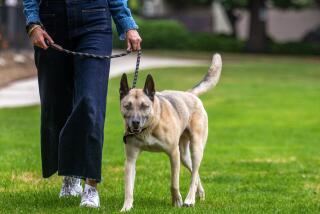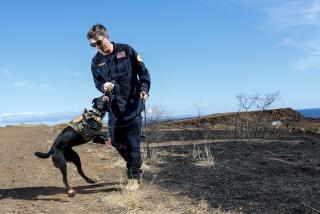Making a Point : Quest Is to Train Dogs to Use Their Basic Instincts as Hunters
- Share via
A chukar partridge flushed from its cover flies so far or runs so fast--usually uphill--that a hunter’s best friend is indisputably his dog.
Dan Anderson of LaVerne has a good one, a German shorthaired pointer named Gunther. When the San Gabriel Valley Chapter of Quail Unlimited staged its fifth annual Gun Dog Showdown at Yucaipa recently, Gunther plunged into a field of knee-high grass, thick from the winter’s rains, and found his quota of three planted chukar for Anderson to shoot, one by one, in 2 minutes 5 seconds.
Other dogs, including Labradors, golden retrievers and English pointers, couldn’t find three in the allotted 10 minutes. German shorthaired pointers (Deutsch Kurzhaar) swept the first three places.
Gunther is probably pretty good at finding missing socks, too. His talent is part instinct, from breeding, and part training.
“Dogs know more about hunting than we do,” says Gary Langdon of Rialto, whose shorthairs won the event the previous two years. “These are pointers. They were on point when they were three weeks old, pointing butterflies in the back yard.”
The next step is to develop those instincts and train the dog to retrieve a fallen bird. Langdon trains his own dogs; others, such as Anderson, have theirs trained by professionals. Anderson took Gunther to Sigbot (Bodo) Winterhelt of Lancaster, who turned him into what Langdon calls “a turn-key dog . . . remote controlled.”
Langdon was not demeaning Anderson’s pooch.
“No, that’s good. One whistle it stops. Two whistles it comes back. His dog does everything on command, whereas my dogs do almost everything on instinct.”
Winterhelt, founder and past president of the North American Versatile Hunting Dog Assn., has spent the last 50 years training more than 3,000 dogs--all in his own way, on his own terms.
“Bodo has to look at your dog before he’ll take it,” Anderson said. “He looks for the dog’s ability, then keeps it for a week on a trial basis. If he doesn’t like it, he won’t train it.”
“I look for temperament,” Winterhelt said. “I want a dog that wants to work.”
Winterhelt also demands that owners stay away for the early part of training when he instills a strong spirit of discipline.
“It’s like--what do the Marines call it?--a boot camp,” he said. “The first four weeks, I don’t want them to come. If the dog sees the owner he thinks everything’s all right. But if the owner isn’t there, pretty soon the dog thinks it isn’t so bad. There is plenty of food and lots of birds to chase. After that I like the owners to come.”
Anderson left Gunther for 2 1/2 months, and when he went to pick up his wonderdog, he said, “He didn’t know me . . . didn’t know me at all.”
The estrangement lasted about a day. The result is not necessarily a canine robot but a dog with a single-minded purpose in life: to find birds.
A mark of a Winterhelt-trained dog is being what hunters call “steady to wing and shot,” plus knowing how to use its eyes as well as its nose. The dog doesn’t bolt when the bird flies or the hunter shoots, not until the hunter commands it to “fetch.” Winterhelt is one of the few trainers to teach that, he said, because “it’s very difficult.”
But the dog will “mark” where the bird falls, run to the spot and, if necessary, locate it by scent.
The benefits of being steady to wing and shot are apparent.
“If your dog will stay with you after the bird flushes out, he’s not in the line of fire,” Anderson said.
“It’s classy, too,” Langdon said. “My dog goes as soon as the bird flushes. Walter’s young. I’m pushing it with him. But what I like about him, he ‘marks’ the bird from a long way off. That’s instinct.”
*
Winterhelt may be more particular than most trainers, but all dogs can be trained to a degree, say Jim Beadle and Phil Mueller of Feather Ranch Kennel in Los Banos. Their kennel offers basic obedience as well as gun dog training. They say attitude means a lot.
“Dogs are going to do what you allow them to do,” Beadle said. “If that’s run your household, they’re more than happy to do that. Training lets them settle into their place. A dog that has been given some restrictions in his life, that understands that he is a dog, is going to train easier and better.
“All of them aren’t going to train as hunting dogs, but any dog can learn obedience. Each dog comes in on a 30-day evaluation period. Then we’ll tell the owner, this is the probable outcome of continuing the training, and decide whether it’s worth continuing.”
Mueller: “We’ve seen dogs that have rundown spirits. If that’s caused by people, you can sometimes regain that animal’s trust. Some dogs have very low self-confidence. They’ve never been mishandled by anyone, but they look as if they’ve been beaten on a daily basis. It’s very difficult to train them, but you can.”
Most training--dogs, kids or football players--is based on reward and correction, administered in doses according to the trainer’s attitude. Some dog owners might be taken aback at the tools Beadle and Mueller use, besides the standard leash and choke chain.
“We use a buggy whip--just a little switch to teach them which direction to move,” Beadle said. “Part of it is for touch and part for sting. We want the dog to understand how to heel and sit, and we’re gonna make him do that. Sometimes there are some negatives involved.”
They also use electric shock collars operated by remote control.
“The electricity gives us a four- or five-hundred-yard leash on the animal,” Mueller said. “You can select the intensity level from almost zero to something that will really get the dog’s attention.
“Electricity is a powerful tool. But it’s important that the animal understands what the electricity is for. Otherwise, he’s out there getting zapped with no idea why.”
Sometimes a dog zaps back.
“I’ve been bitten a few times,” Beadle said. “We may get a little nibble on the hand. If the bite is an aggressive response from the dog, I may retaliate. But most often the bites are misdirected attempts to avoid stress.”
And, most often, the rewards outweigh the corrections.
“We use a couple of kinds of praise,” Beadle said. “Sometimes we give them little biscuits. Food is pretty effective. More often we use verbal or physical praise. You can have a big effect on a dog with a few words--just like people.”
*
Mueller’s greatest challenge was trying to train a half-breed coyote-German shepherd.
“Six months of (working with a) killing machine . . .” he said. “It was over my head.”
He was able to train a white standard poodle--one of the more playful breeds--to be an efficient duck hunting dog.
“Her name was Seagull,” he said. “This dog had one of the best water entries of any dog I’ve ever trained. When she went in, she was flying. Great dog.”
Bill Truxal of Pomona, chairman of the dog trials at Yucaipa, said he prefers to train his own dogs.
“It’s the satisfaction of having a close bond between you and your dog,” Truxal said. “It’s kind of like tying your own flies.”
More to Read
Sign up for Essential California
The most important California stories and recommendations in your inbox every morning.
You may occasionally receive promotional content from the Los Angeles Times.










